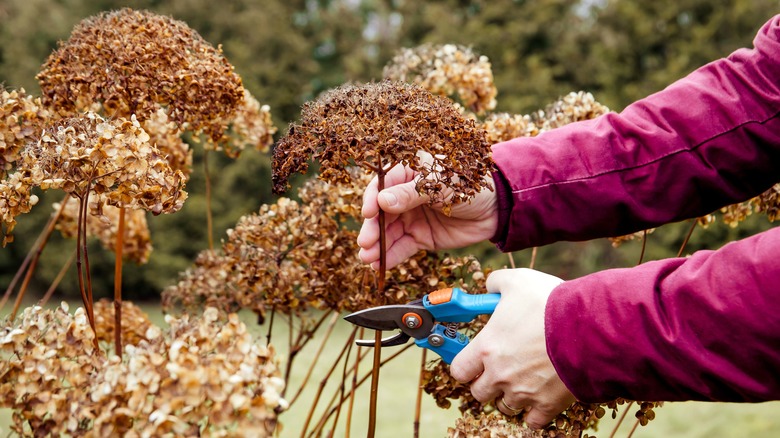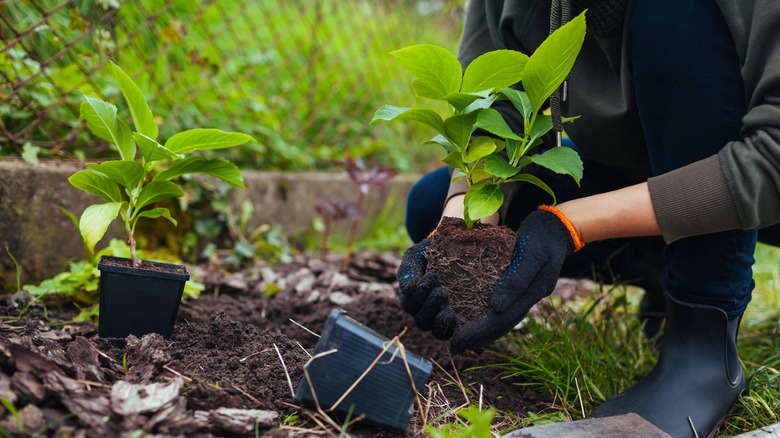Can You Turn A Hydrangea Bush Into A Tree?
More often than not, hydrangeas — also known as hortensias — catch your eye whenever you pass by them. With their vibrant colors, snowball-shaped bouquets, and rich history, it's impossible to come across a patch of hydrangeas and not stop and stare. Long ago, the first hydrangeas bloomed in Japan, not arriving in Europe or North America until the 18th century. Universally, these stunning blooms are still said to be a sign of gratitude, devotion, love, and more, bringing a touch of romance to each garden it blesses. Furthermore, these bountiful flowering shrubs can easily be grown into small trees that can add character and beauty to your garden.
Hydrangeas can be turned into what is popularly known as dwarf trees, a bush-like tree that typically grows no more than 10 feet tall. If you have a small yard, are an amateur gardener, or simply need a unique plant that won't take up your yard, dwarf trees are an efficient and visually appealing option to consider. All you need to do is some digging, planting, soiling, and watering before your hydrangea dwarf tree transforms your yard into a stunning masterpiece, and we have all the advice on how to plant and maintain your new hydrangea tree.
How to plant a hydrangea dwarf tree
After you've selected the ideal hydrangea dwarf tree for your yard, it's time to get planting. For starters, you'll want to identify where in your yard the tree will look best — perhaps near the garden, upfront, in the backyard, etc. Once you've decided on placement, you'll want to dig a hole that's approximately two to three inches wider than the root. Place the tree inside the hole and use your hands to make sure that the roots flare as they reach the bottom of the hole. Cover the roots with the surrounding dirt and top off the plant with lots of water. You'll want to water your hydrangea tree at least three times a week.
Additionally, if you're working with taller plants like limelight hydrangeas, you can transform a previously planted hydrangea bush into a tree by pruning. Pruning is the process of selectively cutting branches to keep your plants growing healthy and undamaged. Start by identifying the strongest stem on the bush and use your hand or a gardening knife to remove the remaining branches. Continue making cuts (without damaging the flowers themselves) until you're satisfied with the shape of the tree. As the season goes on, continue the upkeep of the tree through routine pruning.
How to maintain a hydrangea tree
To give your hydrangea tree the longest life possible, it's important to maintain it well — and we've got you covered. For starters, you'll want to start pruning your hydrangeas at the beginning of spring, making the much-needed cuts that will help them thrive through the warm seasons. Additionally, your hydrangea tree should be receiving enough daily sunlight to stay hydrated, but on a hot summer afternoon, it's equally important to give the tree some time in the shade. You can add an umbrella, tent, or other covering to occasionally protect the plant from the harsh rays of the summer sun.
While hydrangeas are fairly resilient, you'll want to make sure you're feeding the plant enough rich soil, fertilizer, and water to help it grow. Hydrangeas depend on organic matter to thrive and aerate, as the holes in the matter help the air circulate within the soil. Still, you'll want to find a balance between soiling, watering, and fertilizing, since you don't want your plants to suffocate from an overload of nutrients. Instead, follow a consistent upkeep schedule and watch as your hydrangea tree thrives through the warm seasons.


